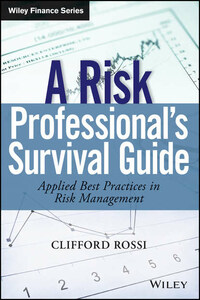The Wiley Finance series contains books written specifically for finance and investment professionals as well as sophisticated individual investors and their financial advisors. Book topics range from portfolio management to e-commerce, risk management, financial engineering, valuation and financial instrument analysis, as well as much more. For a list of available titles, visit our Web site at www.WileyFinance.com.
Founded in 1807, John Wiley & Sons is the oldest independent publishing company in the United States. With offices in North America, Europe, Australia and Asia, Wiley is globally committed to developing and marketing print and electronic products and services for our customers’ professional and personal knowledge and understanding.
Cover image: top: ©iStock.com/blackred;
bottom: ©iStock.com/George Pchemyan
Cover design: Wiley
Copyright © 2014 by Clifford Rossi. All rights reserved.
Published by John Wiley & Sons, Inc., Hoboken, New Jersey.
Published simultaneously in Canada.
No part of this publication may be reproduced, stored in a retrieval system, or transmitted in any form or by any means, electronic, mechanical, photocopying, recording, scanning, or otherwise, except as permitted under Section 107 or 108 of the 1976 United States Copyright Act, without either the prior written permission of the Publisher, or authorization through payment of the appropriate per-copy fee to the Copyright Clearance Center, Inc., 222 Rosewood Drive, Danvers, MA 01923, (978) 750-8400, fax (978) 646-8600, or on the Web at www.copyright.com. Requests to the Publisher for permission should be addressed to the Permissions Department, John Wiley & Sons, Inc., 111 River Street, Hoboken, NJ 07030, (201) 748-6011, fax (201) 748-6008, or online at www.wiley.com/go/permissions.
Limit of Liability/Disclaimer of Warranty: While the publisher and author have used their best efforts in preparing this book, they make no representations or warranties with respect to the accuracy or completeness of the contents of this book and specifically disclaim any implied warranties of merchantability or fitness for a particular purpose. No warranty may be created or extended by sales representatives or written sales materials. The advice and strategies contained herein may not be suitable for your situation. You should consult with a professional where appropriate. Neither the publisher nor author shall be liable for any loss of profit or any other commercial damages, including but not limited to special, incidental, consequential, or other damages.
For general information on our other products and services or for technical support, please contact our Customer Care Department within the United States at (800) 762-2974, outside the United States at (317) 572-3993 or fax (317) 572-4002.
Wiley publishes in a variety of print and electronic formats and by print-on-demand. Some material included with standard print versions of this book may not be included in e-books or in print-on-demand. If this book refers to media such as a CD or DVD that is not included in the version you purchased, you may download this material at http://booksupport.wiley.com. For more information about Wiley products, visit www.wiley.com.
Library of Congress Cataloging-in-Publication Data:
Rossi, Clifford.
A risk professional’s survival guide: applied best practices in risk management / Clifford Rossi.
pages cm. – (Wiley finance)
Includes index.
ISBN 978-1-118-04595-4 (cloth); ISBN 978-1-118-92237-8 (ebk);
ISBN 978-1-118-95304-4 (ebk)
1. Risk management. I. Title.
HD61.R667 2014
658.15′5 – dc23
2014016949
The intent of this book is to provide the next generation of risk leaders, as well as current practitioners of financial risk management, a handy reference of techniques and concepts for identifying, measuring, and mitigating the major risks facing financial institutions. Risk management has evolved over the past decade into a highly quantitative field, drawing on increasingly complex mathematical and statistical concepts to portray a variety of traditional risks such as credit, counterparty, market, and interest rate risk. At the same time, the financial crisis of 2008–2009 laid bare the limitations of sophisticated quantitative analysis. Advances in quantitative risk management will continue; however, risk managers must be mindful of the “art” of risk management, namely judgment and experience that augments the “science” of risk management. Many risk management books focus on the quantitative aspects of the field rather than explore the importance of the qualitative side of risk management. This book is an attempt to bring both perspectives together in a cohesive fashion.
Another feature of this book is to provide readers with a framework for thinking about risk not as a singular outcome, but one that has consequences that may ripple across other parts of the business or risks. Leveraging experience from the crisis and afterward, the book follows the events of SifiBank, a stylized significantly important financial institution that provides the common thread of risk management practices throughout the course of the book. In that regard, this book represents a significant departure from other risk management books in that it is effectively a case study of one large complex commercial bank. To bring that story alive, a synthetic balance sheet is constructed within which specific positions, portfolios and loans are created. This information is then used in a series of Excel/VBA workbooks to provide the reader a hands on companion to the text discussion of key concepts and models.








